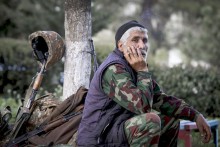Russia’s adventure in Syria made it clear that the Kremlin’s Blitzkrieg wouldn’t work, with the Syrian government troops advancing slowly, sporadically, failing to regain control over areas cleared of insurgents. Worse still, the relationships within the Moscow-Tehran-Damascus triangle left much to be desired as the allies were beginning to drift apart.
As mentioned earlier, it served the Kremlin’s interest to raise the temperature of frozen conflicts alongside Russia’s border. The war in Donbas failed to fit into the Kremlin’s blitz pattern and Project Novorossia proved a stillborn brainchild. There was no way to ignite Transnistria, so Nagorno-Karabakh was the only option. The bulk of the Russian contingent had hardly left Syria when Armenian and Azerbaijani troops clashed along the line of contact.
Official Baku has reiterated that Azerbaijan will never put up with the loss of 20 percent of its territory to Armenia. Talks have been held and UN resolutions passed to no avail for more than 22 years. Not surprisingly, Baku decided that the diplomatic means of settling the conflict had all but been exhausted, whereas Yerevan and Moscow weren’t taking the worst scenario into consideration and regarded Baku’s statement as political rhetoric or propaganda.
Another factor to be considered is that Moscow and most likely Yerevan, for reasons best known to themselves, were convinced that the Azerbaijani army was weak. It was – 22 years back. The reasons behind this conviction are subject to an in-depth military and historical analysis. Suffice it to say that Baku has had enough time to use its financial resources to upgrade the armed forces. The Azerbaijani offensive must have taken the Armenian side by surprise, as evidenced by the results of the attack.
Baku’s unilateral ceasefire most likely will not ease the tension in the region, for several regional and geopolitical reasons.
First. Azerbaijani morale, shaken by the defeats in the early 1990s and the 1994 truce that was obviously to Baku’s disadvantage, had to be restored – and this could be achieved only by restoring what Baku saw as territorial integrity. When diplomats are silent, guns speak up. Azerbaijanis needed to win a victory, even a small one, and they appear to have done just that.
Second. Moscow’s mounting demonstrative aggressive attitude toward first Georgia and then Ukraine made it clear that the Kremlin would supply armaments to Armenia and exert military and political pressure on Azerbaijan. The best way to protect oneself from an aggressive neighbor was by strengthening one’s defenses and showing one’s ability to respond in kind to that neighbor’s attack – and that aggressive neighbor wasn’t Russia but its ally, Armenia.
Third. The South Caucasus is important to Russia strategically, about as much as Ukraine is. Moscow’s position in that region has noticeably weakened. After the annexation of part of Georgian territory all attempts to improve relationships with Tbilisi have failed, with the replacement of the Georgian political leadership even quickening Tbilisi’s drifting Westward.
Moscow has consistently been supporting Yerevan, to the detriment of relationships with the other countries in this region. Much as Baku has tried, there has been little progress in Russia-Azerbaijan relationships. Tbilisi and Baku were spoken to in a language of force, so they responded in the same language. As a result, Armenia, being Russia’s ally with hands tied, has found itself in a territorial and economic semi-blockade. In a way, this situation is OK by Moscow because the local pro-Western opposition forces can’t strengthen under the circumstances.
There is also Tehran trying to expand its sphere of influence in Armenia, considering the common border and energy supplies. Moscow is chagrined but remains officially silent. (Incidentally, this could serve to keep Russia’s aggressive ambitions in check because a confrontation with Iran is the last thing Moscow would want.)
Fourth. By fueling the Nagorno-Karabakh fire Moscow is attempting to open the third front against Ankara. With the first one in Syria and the second one manned by Kurds, Turkey has to spread its forces, thus weakening its positions on the first and second fronts.
At this stage Russia will not get directly involved in the conflict, not with Nagorno-Karabakh being the site and there being no legal reasons. However, there is the clear and present danger of Armenia launching provocations on its border with Azerbaijan in case the Azerbaijani forces win further battles. In that case Armenia will expect aid from the Collective Security Treaty Organization – in other words, military intervention on the part of Russia. Doubtlessly, other CSTO member countries, especially the Turkic-speaking ones, won’t lift a finger to help.
Therefore, Russian diplomats are tasked with (a) fueling the conflict fire, in order to weaken both Armenia and Azerbaijan, and (b) preventing a local conflict from evolving into a full-scale war, keeping it proxy war, like the one in Donbas. An Oriental saying has it that war is war and semi-war is also war.
Note that the more complex the economic and financial situation in Russia, the more its aggressiveness – primarily against its closest neighbors, although those further from Russia also suffer.
Russia’s aggressive actions, fueling world tensions, are meant to fulfill the Kremlin’s plan to strengthen its position during the negotiations with the new US administration. This means that guns will continue speaking in Nagorno-Karabakh and Donbas.








